The Magnesium Stearate Market is estimated to be valued at USD 38.3 billion in 2025 and is projected to reach USD 65.4 billion by 2035, registering a compound annual growth rate (CAGR) of 5.5% over the forecast period.
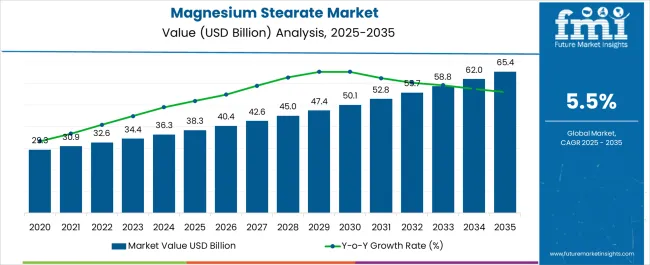
| Metric | Value |
|---|---|
| Magnesium Stearate Market Estimated Value in (2025 E) | USD 38.3 billion |
| Magnesium Stearate Market Forecast Value in (2035 F) | USD 65.4 billion |
| Forecast CAGR (2025 to 2035) | 5.5% |
The magnesium stearate market is witnessing stable growth, supported by its wide use as a lubricant, emulsifier, and stabilizing agent across industries such as pharmaceuticals, food, and cosmetics. Increasing demand from the pharmaceutical sector, where it is extensively utilized in tablet and capsule formulations to prevent ingredients from sticking during production, is providing strong momentum. The compound’s multifunctional role in improving consistency, enhancing shelf life, and supporting high-speed manufacturing processes is further strengthening its adoption.
Regulatory approvals in major regions are ensuring continued use in critical applications, while growing demand from nutraceuticals and dietary supplements is adding to its market scope. The rising consumption of processed foods and personal care products is also stimulating growth, as magnesium stearate is increasingly incorporated as a flow agent and texturizer.
Market expansion is additionally being influenced by the global emphasis on high-quality excipients that comply with international safety standards With ongoing advances in production methods and the rising importance of cost-effective, versatile additives, the market is positioned for steady long-term growth across both developed and emerging economies.
The magnesium stearate market is segmented by form, end use application, and geographic regions. By form, magnesium stearate market is divided into Powder and Flakes. In terms of end use application, magnesium stearate market is classified into Pharmaceuticals, Bakery, Beverages, Confectionary, Dairy, Jams, Soups, Sauces, Dressings, and Condiments, Processed Food and Beverages, Infant Formula, Beauty and Personal Care, and Animal Feed. Regionally, the magnesium stearate industry is classified into North America, Latin America, Western Europe, Eastern Europe, Balkan & Baltic Countries, Russia & Belarus, Central Asia, East Asia, South Asia & Pacific, and the Middle East & Africa.
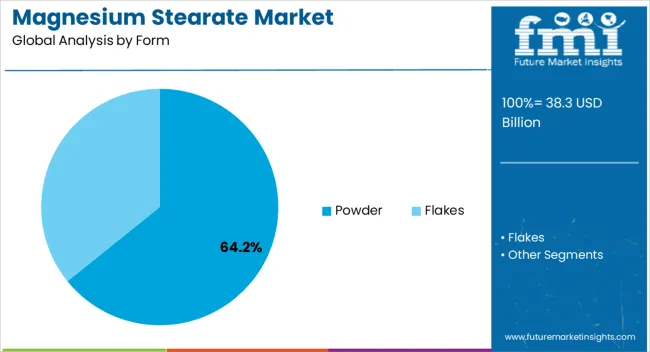
The powder form segment is projected to hold 64.2% of the magnesium stearate market revenue share in 2025, positioning it as the leading form. This dominance is being reinforced by the segment’s suitability for a broad range of applications, particularly in pharmaceuticals and nutraceuticals, where powdered excipients are highly preferred due to ease of blending and uniform dispersion. Powdered magnesium stearate enhances the efficiency of tablet and capsule manufacturing processes by acting as an effective lubricant and flow agent, reducing friction and ensuring consistency in dosage forms.
Its high compatibility with active pharmaceutical ingredients and excipients has further strengthened its role in advanced formulations. Beyond pharmaceuticals, powdered magnesium stearate is also extensively applied in food processing and cosmetic production, where it improves product stability and texture.
The segment is benefiting from the scalability of production processes, which ensure cost-effectiveness while maintaining compliance with global quality standards As manufacturers increasingly prioritize efficiency and reliability in large-scale operations, the powder form is expected to maintain its leadership position in the global market.
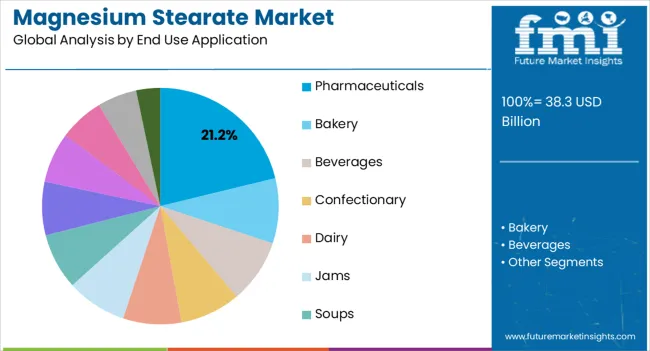
The pharmaceuticals segment is anticipated to account for 21.2% of the magnesium stearate market revenue share in 2025, making it the leading end use application. Its leadership is being driven by the extensive utilization of magnesium stearate as a critical excipient in solid dosage forms, including tablets and capsules. The compound’s ability to function as a lubricant and release agent reduces friction during compression and enhances the efficiency of high-speed production lines.
This has been vital in ensuring consistent dosage delivery, improved product quality, and extended shelf stability. The pharmaceuticals segment is also supported by rising global demand for over-the-counter drugs, generics, and dietary supplements, all of which require excipients that meet stringent safety and performance standards.
With increasing emphasis on Good Manufacturing Practices and international regulatory compliance, pharmaceutical companies are favoring excipients that provide proven safety and reliability The growing prevalence of chronic diseases, coupled with expanding healthcare access in emerging markets, is further strengthening demand, ensuring that pharmaceuticals remain the dominant end use application for magnesium stearate.
Innovation Stimulates the Magnesium Stearate Market to Go Beyond the Basics
The quest for improved performance and addressing limitations of magnesium stearate is driving innovation in its formulations. Researchers are exploring surface modification techniques, where the particles are coated with specific materials. This could enhance compatibility with other ingredients in a product, leading to more uniform mixtures in tablets or improving lubrication efficiency.
Another exciting avenue is the development of nanosized magnesium stearate. These nanoparticles offer a larger surface area, potentially making them more effective in applications like drug delivery, allowing for more targeted medication release within the body.
With an eye toward sustainability, research into alternative production methods with a lower environmental footprint is underway. These innovations have the potential to unlock new possibilities and further solidify the product's position as a crucial ingredient across various industries.
Expanding Reach of Magnesium Stearate with Research Fundings
Funding fuels innovation in the magnesium stearate industry. It unlocks new applications in drug delivery, bioplastics, and cosmetics, creating fresh market segments. Research dollars also improve existing formulations through surface modifications, nano-sizing, and efficient production methods. This translates to better-performing products, potentially increasing adoption and market value.
Funding supports the development of sustainable production methods, aligning with the growing demand for eco-friendly ingredients. By fueling innovation across various aspects, research funding strengthens the magnesium stearate market's position and propels it towards a more dynamic future.
Challenges on the Horizon for the Magnesium Stearate Market
The magnesium stearate market isn't without its challenges. Fluctuations in raw material prices, particularly stearic acid, can cause market instability and impact production costs. Additionally, stringent regulations regarding safety and quality standards in the pharmaceutical and food industries can pose hurdles for manufacturers.
The presence of readily available substitutes, like calcium stearate and sodium stearyl fumarate, is further creating a competitive landscape. This could potentially limit market growth.
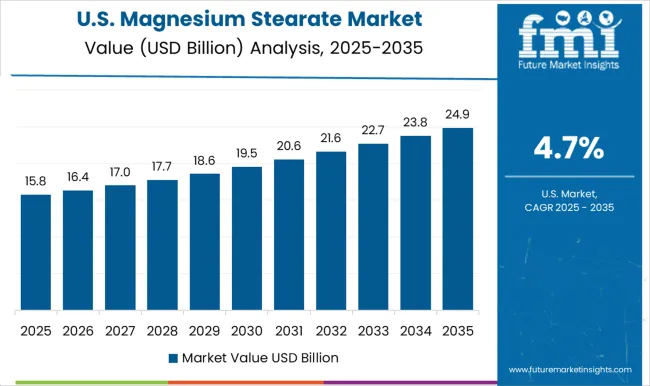
Magnesium stearate market trends in the United States show two contrasting viewpoints. On one hand, certain reports highlight a potential rise in demand driven by the buoyant United States economy with increased consumer spending. This is expected to lead to a rise in demand for products that typically use magnesium stearate, such as pharmaceuticals, food and beverages, and cosmetics.
Stringent quality and safety standards in the United States pharmaceutical industry is projected to drive the use of reliable and well-established ingredients like magnesium stearate in medication production. This will likely boost sales growth through 2035.
A growing awareness of potential health risks associated with some additives, including magnesium stearate, is however anticipated to lead some consumers to choose products free of such ingredients. This might impact its use in cosmetics and certain food products.
Future market predictions for magnesium stearate in Germany seem to be substantial. Germany boasts a robust pharmaceutical sector, consistently ranked among the world's leaders. This translates to a high product demand, a critical ingredient in efficient and reliable medication production.
A rising health consciousness among German consumers might indirectly benefit the magnesium stearate market. As demand for high-quality pharmaceuticals and nutraceuticals increases, the need for reliable excipients like magnesium stearate grows alongside it.
In India, players operating in the magnesium stearate industry are continuously adapting to the shifting consumer preferences. India's growing economy is leading to an increase in disposable income. This translates to a greater demand for various products that utilize magnesium stearate, such as pharmaceuticals, personal care products, and processed food items.
Concerns surrounding the product's safety, though not always substantiated by scientific evidence, might influence consumer choices in certain segments like cosmetics. Nevertheless, the overall outlook for the magnesium stearate market in India remains positive due to the strong growth drivers mentioned above.
Powdered magnesium stearate's rise in sales can be attributed to its versatility. Compared to other forms, it boasts better flow and a larger surface area, making it ideal for various applications.
In pharmaceuticals, powdered form acts as a lubricant during production, while in food and cosmetics, it prevents clumping and aids smooth application. Additionally, its cost-effective production and potential for exciting new uses in drug delivery and bioplastics solidify its position as a valuable industrial ingredient.
The pharmaceutical sector reigns supreme in magnesium stearate consumption. It acts as a lubricant during production, preventing ingredient sticking and ensuring consistent flow for uniform dosages. With a proven safety record, cost-effectiveness, and contribution to overall product quality, magnesium stearate remains a vital ingredient for pharmaceutical companies.
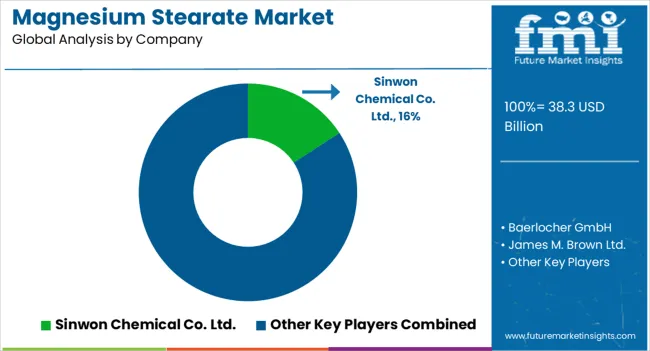
In the competitive landscape of the magnesium stearate industry, key players are employing various strategies to expand their market share. One approach is through analysis of magnesium stearate market distribution channels. By identifying the most efficient routes to reach end-users, such as direct sales to pharmaceutical companies or partnerships with distributors specializing in food and personal care ingredients, companies can optimize their reach and ensure consistent product availability.
Key players are further investing in research and development to create innovative product formulations with improved functionalities. This can involve developing grades with superior lubricating properties or exploring nano-sized particles for targeted drug delivery. By offering differentiated products that address specific market needs, companies can carve out a competitive edge and attract new customers.
Company Details
The company manufactures several chemical compounds that are used in PVC stabilizers, masterbatches, flame retardants, and other applications. Sinwon Chemical sells magnesium stearate under the name of HI-MAST. This compound is developed using raw ingredients and clean facilities, leading to a pure chemical compound.
This Germany-based science and technology MNC is headquartered in Darmstadt, Germany, and has over 60,000 employees, with a presence in over 66+ countries. The company operates across the life science, healthcare, and electronics domains. The firm formulates Parteck® LUB (Lubricant) products, which is a vegetable-origin magnesium stearate.
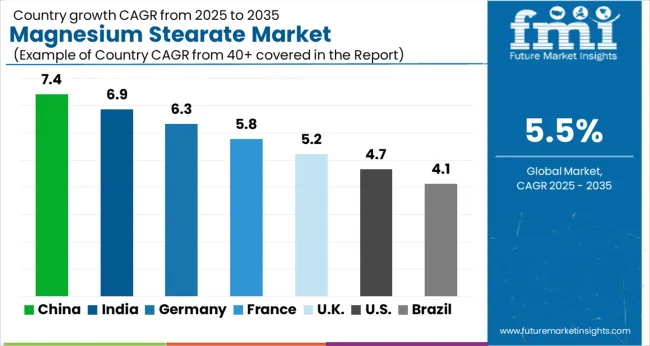
| Country | CAGR |
|---|---|
| China | 7.4% |
| India | 6.9% |
| Germany | 6.3% |
| France | 5.8% |
| UK | 5.2% |
| USA | 4.7% |
| Brazil | 4.1% |
The Magnesium Stearate Market is expected to register a CAGR of 5.5% during the forecast period, exhibiting varied country level momentum. China leads with the highest CAGR of 7.4%, followed by India at 6.9%. Developed markets such as Germany, France, and the UK continue to expand steadily, while the USA is likely to grow at consistent rates. Brazil posts the lowest CAGR at 4.1%, yet still underscores a broadly positive trajectory for the global Magnesium Stearate Market. In 2024, Germany held a dominant revenue in the Western Europe market and is expected to grow with a CAGR of 6.3%. The USA Magnesium Stearate Market is estimated to be valued at USD 13.6 billion in 2025 and is anticipated to reach a valuation of USD 21.5 billion by 2035. Sales are projected to rise at a CAGR of 4.7% over the forecast period between 2025 and 2035. While Japan and South Korea markets are estimated to be valued at USD 2.0 billion and USD 1.1 billion respectively in 2025.
| Item | Value |
|---|---|
| Quantitative Units | USD 38.3 Billion |
| Form | Powder and Flakes |
| End Use Application | Pharmaceuticals, Bakery, Beverages, Confectionary, Dairy, Jams, Soups, Sauces, Dressings, and Condiments, Processed Food and Beverages, Infant Formula, Beauty and Personal Care, and Animal Feed |
| Regions Covered | North America, Europe, Asia-Pacific, Latin America, Middle East & Africa |
| Country Covered | United States, Canada, Germany, France, United Kingdom, China, Japan, India, Brazil, South Africa |
| Key Companies Profiled | Sinwon Chemical Co. Ltd., Baerlocher GmbH, James M. Brown Ltd., Merck KGaA, Hefei TNJ Chemical Industry Co. Ltd., Thermo Fisher Scientific Inc., Peter Greven GmbH & Co. KG, Struktol Company of America LLC, Haihang Industry Co. Ltd., Tokyo Chemical Industry Co. Ltd., and Others |
The global magnesium stearate market is estimated to be valued at USD 38.3 billion in 2025.
The market size for the magnesium stearate market is projected to reach USD 65.4 billion by 2035.
The magnesium stearate market is expected to grow at a 5.5% CAGR between 2025 and 2035.
The key product types in magnesium stearate market are powder and flakes.
In terms of end use application, pharmaceuticals segment to command 21.2% share in the magnesium stearate market in 2025.
Explore Similar Insights

Thank you!
You will receive an email from our Business Development Manager. Please be sure to check your SPAM/JUNK folder too.
Chat With
MaRIA